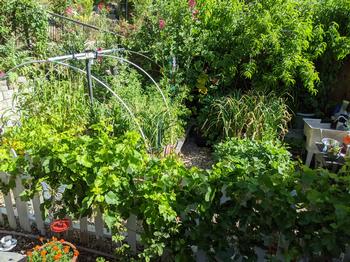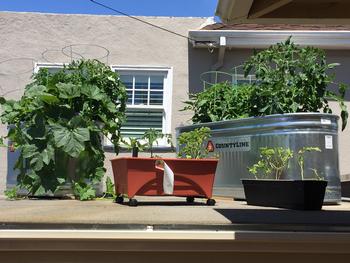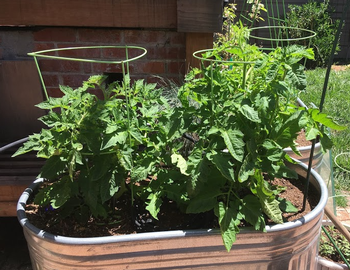Growing Vegetables in a Small Space - 6 Tips You Can Use Today
by Linda Carloni
Small spaces are bigger than you think. A small plot or containers on a deck or balcony can grow a remarkable amount of food. Just like bigger plots, small spaces need to provide fertile soil, good sun, and appropriate watering.

- The variety of a vegetable is important. Tomatoes and squash can grow on huge plants, but there are also varieties of smaller size. Consider varieties labeled “patio” or stated to be good for containers. Stay away from varieties labeled “giant”, “whopper” or the like. Make sure the vegetable you want to plant is suitable to plant at the time you want to plant it.
- Go up! Pole beans, cucumbers and snap and snow peas can produce a lot in a little horizontal space if trellised. Pole beans and peas grow well up twine secured 6 to 8 feet higher than the earth where they are planted. You may need to nudge them towards and up the twine at first, but they will catch on. Cucumbers are good on a sloped trellis – it keeps the fruit off the dirt and makes them straighter and easier to find. Place the trellis or twine for climbing at the time you plant, to avoid the possibility of damaging the plant while placing it at a later time.
- Don’t waste the space! You can grow two or more vegetables in one area by planting slower-maturing and faster-maturing crops together. The quick-to-mature vegetables will be ready for harvest before the two crops begin to crowd each other. Once the fast crop is picked, the slower crop will have more room to grow to maturity. Examples include planting the seeds of radishes (fast) and carrots (slow) in the same area, or alternating rows of leaf lettuce (fast) and tomatoes (slow). You can also grow leafy vegetables in a wide row (8 to 12 inches wide) instead of a row of single plants. When the plants grow, they can provide a leaf canopy that suppresses weed growth and conserves water. When you’ve planted a vertical crop, once the crop is growing well up its support, put some smaller plants like lettuce in the room around the base. Make sure you’re providing enough water for all the plants using the space.
 Rooftop garden - photo credit Erin Wright
Rooftop garden - photo credit Erin Wright - Succession planting. As soon as one crop is done, plant another appropriate to the coming season. It’s frequently possible to get two crops of bush beans in during our long summer season, for example. Or as you cut down the determinate tomatoes that have finished producing, plant some potatoes or carrots for the fall.
 Patio tomatoes in trough - photo credit Erin Wright
Patio tomatoes in trough - photo credit Erin Wright - Grow over multiple seasons. In the San Francisco Bay Area, we can grow in the spring, summer, and fall, and some gardeners even extend their food growing into the winter. Many of our leafy greens – lettuce, spinach, and kale for example – grow better in somewhat cooler weather than our hot dry summers. Crops like broccoli, bok choy, and cabbage have fewer pest problems in cooler weather as well.
- Feed your soil.
- Most vegetables, particularly melons, squashes, corn, and cole crops such as cauliflower and cabbage, are “heavy feeders”, using a lot of nutrition from the soil.
- Growing vegetables over multiple seasons and keeping the soil continuously in use requires soil amendment and fertilizer, and more than is needed for single-season gardening. Before you start each new plant, add compost and/or another source of nitrogen. Compost will provide not just nitrogen but also valuable organic matter to improve the texture of your soil. You can even make your own!
- Other good sources of nitrogen are fish emulsion, blood meal, or a dry fertilizer with a high “N” number. If you use a dry, concentrated fertilizer, be careful to follow the package directions, as too much can cause runoff that’s bad for our streams and the Bay.
- Many crops also benefit from some complete fertilizer containing phosphorus and potassium. If you are planting in sandy soil or a container, plant nutrition is likely needed more often than if you are planting in clay soil.
- Consider occasionally giving an area a rest and planting a cover crop to restore it.
Then relax and enjoy the vegetable bounty your small space has provided!
Resources:
Your Garden Month-by-Month Guide
http://acmg.ucanr.edu/Your_Garden_Month-by-Month/
Collection of articles - http://acmg.ucanr.edu/Growing_Your_Own_Food/Growing_Vegetables/
Making compost: http://acmg.ucanr.edu/Growing_Your_Own_Food/Improve_Your_Soil_With_Compost/
Two good resources with much more detail on amending and fertilizing soil: https://ucanr.edu/blogs/dirt/?mobileview=normal and http://cagardenweb.ucanr.edu/Vegetables/?uid=26&ds=462 .
This Iowa State University Extension article has more detail on many of these space-saving techniques for vegetable gardening:
https://store.extension.iastate.edu/product/Small-Plot-Vegetable-Gardening
Still need help?
Want additional help? Confused? Email us at acmg@ucanr.edu. Or contact us through our website http://acmg.ucanr.edu/Contact_Us/ .



